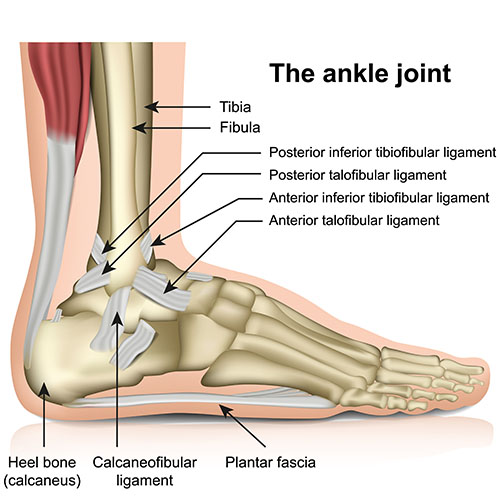- Posterior Tibialis: supports the foot’s arch
- Anterior Tibialis: allows upward movement

From walking on an uneven surface to landing hard while playing sports, there are numerous ways that an ankle sprain may happen. As one of the most common injuries in the United States, ankle sprains occur when one or more of the ligaments in the joint stretch beyond their limitations. An ankle sprain can be classified into three grades:
You may experience swelling, bruising, pain, and inability to bear weight on the affected leg if you have sprained your ankle. It is important to seek medical attention at Comprehensive Medical Care if encountering these symptoms because, if left untreated, you are at higher risk to re-sprain your ankle or develop chronic pain. Fortunately, a majority of ankle sprains can be treated with nonsurgical treatment.
A foot and ankle fracture can occur to any of the 26 bones in the region and may range from a minor hairline fracture to a complete bone break. Fractures typically happen due to a sudden twisting motion of the lower leg or a significant blow to the region. You can usually distinguish a fracture from an ankle sprain through the presence of a deformity to the bone in the foot or ankle. To confirm the presence of a fracture, make an appointment with Comprehensive Medical Care so that our orthopedic specialists can perform imaging tests like an X-ray or an MRI for an accurate diagnosis.
The plantar fascia is a thick band of fibrous tissue that runs along the underside of your foot and supports the foot’s arches. Plantar fasciitis occurs when the plantar fascia becomes inflamed, resulting in pain and stiffness. Some risk factors of developing this fairly common condition include:
Treating plantar fasciitis usually entails nonsurgical treatment like splints, physical therapy, rest, and lifestyle modifications.
The Achilles is the largest tendon in our body and is essential to walking, running, and jumping. Due to the repetitive stress on our achilles, the tendon can become irritated or inflamed. Achilles tendonitis may also occur due to:
You will often experience pain, swelling, and a limited range of motion with Achilles tendonitis. If you hear or feel a popping sensation in the back of your heel at any point in time, it is crucial to see an orthopedic specialist to make sure that you have not ruptured the tendon.
When diagnosed with a foot and ankle injury, our team at Comprehensive Medical Care usually recommends the use of nonsurgical treatment before deciding on surgery. Some typical treatment options are:
For severe injuries to the foot and ankle, surgical intervention may be necessary. Surgeries that our practice offers include:








Monday: 9:00 AM – 8:00 PM
Tuesday: 9:00 AM – 8:00 PM
Wednesday: 9:00 AM – 8:00 PM
Thursday: 9:00 AM – 8:00 PM
Friday: 9:00 AM- 6:00 PM
Sat-Sun: CLOSED
311 Spotswood Englishtown Road
Monroe Township, NJ 08831
Monday: 9:00 AM – 8:00 PM
Tuesday: 9:00 AM – 8:00 PM
Wednesday: 9:00 AM – 8:00 PM
Thursday: 9:00 AM – 8:00 PM
Friday: 9:00 AM- 6:00 PM
Sat-Sun: CLOSED
All Rights Reserved – 2024 | Website Managed by Five Star SEO